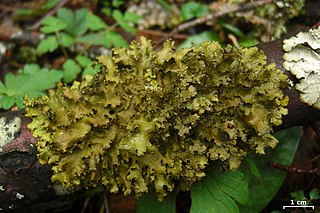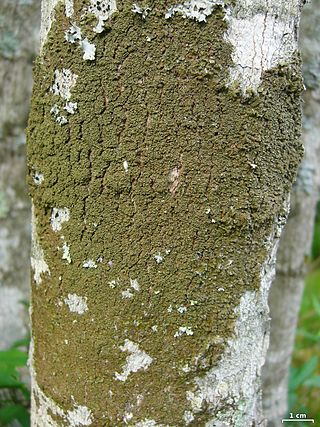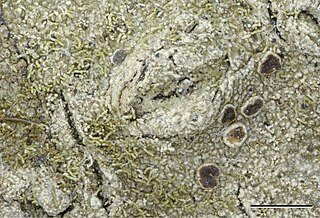
The Parmeliaceae is a large and diverse family of Lecanoromycetes. With over 2700 species in 71 genera, it is the largest family of lichen-forming fungi. The most speciose genera in the family are the well-known groups: Xanthoparmelia, Usnea, Parmotrema, and Hypotrachyna.

Allocetraria is a genus of lichenized fungi in the family Parmeliaceae. It consists of 12 species, with a center of distribution in China.

Cetrariella is a genus of foliose lichens in the family Parmeliaceae. It contains three species.
Cetreliopsis is a genus of four species of lichens in the family Parmeliaceae.

Kaernefeltia is a genus of lichenized fungi in the family Parmeliaceae.

Masonhalea is a genus of two species of lichenized fungi in the family Parmeliaceae.

Tuckermannopsis is a genus of foliose lichens in the family Parmeliaceae.

Melanohalea is a genus of foliose lichens in the family Parmeliaceae. It contains 30 mostly Northern Hemisphere species that grow on bark or on wood. The genus is characterized by the presence of pseudocyphellae, usually on warts or on the tips of isidia, a non-pored epicortex and a medulla containing depsidones or lacking secondary compounds. Melanohalea was circumscribed in 2004 as a segregate of the morphologically similar genus Melanelia.

Parmelinella is a genus of lichen belonging to the family Parmeliaceae. The genus was circumscribed in 1987 by John Elix and Mason Hale as a segregate of Parmelina, from which it differs in having larger ascospores and containing salazinic acid. Although the genus had been assumed to be well-defined morphologically, a 2021 molecular phylogenetic study suggests that the generic delimitations need to be revised.

Parmotrema is a genus of lichen belonging to the family Parmeliaceae. It is a large genus, containing an estimated 300 species, with a centre of diversity in subtropical regions of South America and the Pacific Islands.

Punctelia is a genus of foliose lichens belonging to the large family Parmeliaceae. The genus, which contains about 50 species, was segregated from genus Parmelia in 1982. Characteristics that define Punctelia include the presence of hook-like to thread-like conidia, simple rhizines, and point-like pseudocyphellae. It is this last feature that is alluded to in the vernacular names speckled shield lichens or speckleback lichens.

Nesolechia is a genus of parasitic fungi in the family Parmeliaceae. All three species in the genus grow on lichens. Nesolechia probably evolved from a lichen ancestor, as it is closely related to many lichenized species of fungi.
Cetrariopsis is a genus of foliose lichens in the large family Parmeliaceae. The genus contains three species, including the type, Cetrariopsis wallichiana.

Phacopsis is a genus of lichenicolous (lichen-dwelling) fungi. They are parasites of members of the large lichen family Parmeliaceae, of which they are also a member. Originally proposed by Edmond Tulasne in 1852 to contain 3 species, Phacopsis now contains 10 species, although historically, 33 taxa have been described in the genus. Many of the species are poorly known, some of them having been documented only from the type specimen.

Tuckermanella is a genus of lichen-forming fungi in the family Parmeliaceae.
Austromelanelixia is a genus of five species of foliose lichens in the family Parmeliaceae. All species are found in the Southern Hemisphere.

Neoprotoparmelia is a genus of crustose lichens that was created in 2018. It contains 24 tropical and subtropical species that mostly grow on bark. Neoprotoparmelia is in the subfamily Protoparmelioideae of the family Parmeliaceae, along with the morphologically similar genera Protoparmelia and Maronina.

Usnocetraria is a genus of foliose lichens in the family Parmeliaceae.

Rhizocarpales are an order of lichen-forming fungi in the subclass Lecanoromycetidae of the class Lecanoromycetes. It has two families, Rhizocarpaceae and Sporastatiaceae, which contain mostly crustose lichens.
Raesaenenia is a fungal genus in the large family Parmeliaceae. It is a monotypic genus, containing the single lichenicolous fungus Raesaenenia huuskonenii, which parasitises lichens of genus Bryoria in the Northern Hemisphere.
















